We can learn from past mistakes and consciously choose new ways of navigating these great energy influxes to create periods of human flourishing and humanitarian advances. When outdated structures that do not serve humanity collapse, an opportunity opens for them to be replaced with more suitable and sustainable models. Such positive change can affect political, economic, medical and educational systems as well as people’s relationships in their workplaces, homes and communities.
Earth rhythms
Earth has a strong internal magnetic field that appears to be generated by electrical currents in the liquid outer iron core that are driven by internal heat sources. The magnetic field resembles that of a bar magnet or “dipole field” with an axis tilted about 11.5 degrees from the spin axis, so, the magnetic poles are not the same as the geographic poles. Earth’s magnetic field strength was first measured by Carl Friedrich Gauss in 1835 and has been measured repeatedly since then. The field has shown a relative decay of about 10% over the last 150 years. The locations of the magnetic poles are not static; they wander as much as 55 kilometers every year.
The geomagnetic field is influenced by the sun and moon’s rotations, solar flares and probably interplanetary influences. Animals, including birds, can detect Earth’s magnetic field and use it to navigate during migration. It has been shown, for example, that cows and deer, when grazing, tend to align their bodies north-south in response to the earth’s magnetic field.
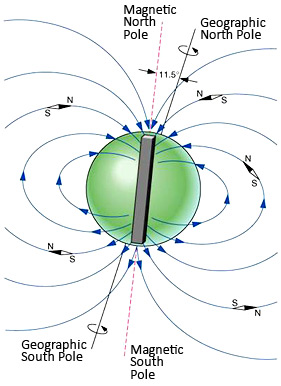
Image copyright HeartMath Institute.
The forces of the solar wind include charged particles that push against Earth’s magnetic field. Because of the solar wind, the portion of the geomagnetic field facing the sun is pushed in toward the earth’s surface and flattened when the portion of the field facing away from the sun, known as the magnetotail, is pulled away from Earth. (See figure below.) A visible phenomenon of the collision of charged solar particles with Earth’s magnetic field is auroras, or the northern and southern polar lights, which are commonly known as the aurora borealis and aurora australis.
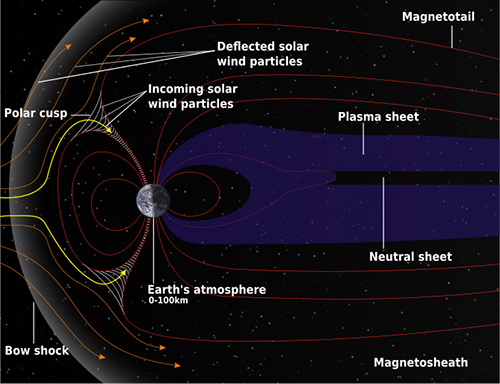
Image copyright HeartMath Institute.
When the solar wind meets the earth’s magnetic field it causes various types of complex oscillations in the field that often are referred to as micropulsations and field line resonances. Based on their waveforms, magnetic pulsations and field line resonances have been classified as pulsations that are continuous (Pc) and pulsations that irregular (Pi). Because their frequencies are so low, they are usually characterized by their period of oscillation rather than frequency.
There are a variety of mechanisms that produce these oscillations, such as interactions of solar wind and the earth’s main magnetic field lines; sudden solar wind pressure changes that move/push the field in or allow it to expand out; and sudden changes in solar wind direction that cause the magnetotail to stretch and snap back. The figure below shows an example of these field line resonances, recorded at the GCI magnetometer site in Boulder Creek, Calif. Important note: The frequencies of these field line resonances are in the same range as many of the rhythms found in human and animal cardiovascular and autonomic nervous-system functions.
In the Boulder Creek site example, there is a clear frequency at 0.1 hertz, which is the same frequency as the heart rhythm of someone who is in a heart-coherent state. Research has shown that changes in these ultralow frequencies (ULF’s, also called Pc and Pi), caused by solar activity and changes in geomagnetic activity can affect human health and behavior.
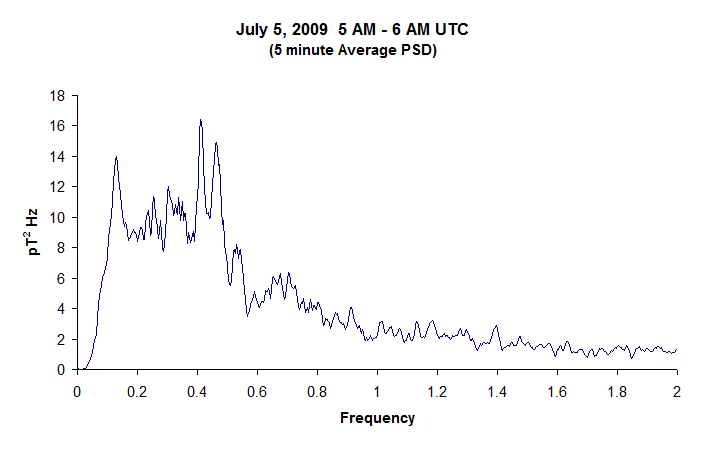
Image copyright HeartMath Institute.
Geomagnetic field line resonance data recorded from the GCI sensor site in Boulder Creek, Calif. Note that all the resonant frequencies overlap human autonomic and cardiovascular system frequencies. In this example, there is a clear standing wave frequency at 0.1 hertz, which is the same frequency of our heart rhythms when we are in a coherent state.
Schumann resonances
Schumann resonances are global electromagnetic resonances in the cavity formed between the earth’s surface and the ionosphere. Schumann resonances were named after German physicist Winfried Schumann, who first predicted them in 1952. Electromagnetic impulses like those from global lightning flashes (Earth’s thunderstorm activity) fill this cavity and excite the Schumann resonances. The first accurate measurements of the Schumann resonances were made from 1960 to 1963 and since then there has been an increasing interest in them across a wide variety of fields.
Radiation from the sun ionizes part of the earth’s upper atmosphere and forms a conductive plasma layer, the ionosphere. The ionosphere surrounding our planet is negatively charged relative to the earth’s surface, which creates a strong electrical field between the earth and ionosphere. Schumann resonances occur because the space between the surface of the earth and the conductive ionosphere acts as a closed waveguide. This waveguide acts as a resonant cavity for electromagnetic waves. Schumann resonances appear as distinct peaks at extremely low frequencies starting around 7.8 hertz, which is considered the fundamental frequency.
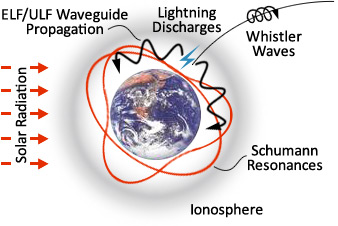
Schumann resonances in Earth-ionosphere cavity. Image courtesy NASA.
Resonances can be observed at around 7.8, 14, 20, 26, 33, 39 and 45 hertz, with a daily variation of about ± 0.5 hertz, which is caused by the daily increase and decrease in the ionization of the ionosphere due to UV radiation from the sun (also see the live data).
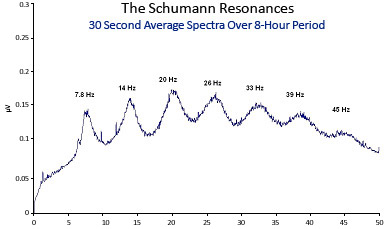
Image copyright HeartMath Institute.
No comments yet.